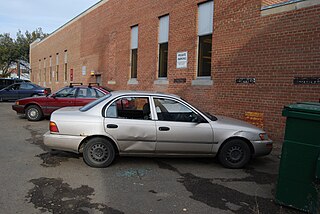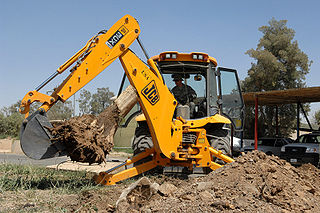
Motor vehicle theft is the criminal act of stealing or attempting to steal a motor vehicle. Nationwide in the United States in 2020, there were 810,400 vehicles reported stolen, up from 724,872 in 2019. Property losses due to motor vehicle theft in 2020 were estimated at $7.4 billion. There were 505,100 car thefts in the EU in 2019, a 43% decrease from 2008.

Carjacking is a robbery in which a motor vehicle is taken over. In contrast to car theft, carjacking is usually in the presence and knowledge of the victim. A common crime in many places in the world, carjacking has been the subject of legislative responses, criminology studies, and prevention efforts. Commercial vehicles such as trucks and armored cars containing valuable cargo are common targets of carjacking attempts. Carjacking usually involves physical violence to the victim, or using the victim as a hostage. In rare cases, carjacking may also involve sexual assault.

Art theft, sometimes called artnapping, is the stealing of paintings, sculptures, or other forms of visual art from galleries, museums or other public and private locations. Stolen art is often resold or used by criminals as collateral to secure loans. Only a small percentage of stolen art is recovered—an estimated 10%. Many nations operate police squads to investigate art theft and illegal trade in stolen art and antiquities.
Laptop theft is a significant threat to users of laptop and netbook computers. Many methods to protect the data and to prevent theft have been developed, including alarms, laptop locks, and visual deterrents such as stickers or labels. Victims of laptop theft can lose hardware, software, and essential data that has not been backed up. Thieves also may have access to sensitive data and personal information. Some systems authorize access based on credentials stored on the laptop including MAC addresses, web cookies, cryptographic keys and stored passwords.

A utility bicycle, city bicycle, urban bicycle, European city bike (ECB), Dutch bike, classic bike or simply city-bike is a bicycle designed for frequent very short, very slow rides through very flat urban areas. It is a form of utility bicycle commonly seen around the world, built to facilitate everyday short-distance riding in normal clothes in cold-to-mild weather conditions. It is therefore a bicycle designed for very short-range practical transportation, as opposed to those primarily for recreation and competition, such as touring bicycles, road bicycles, and mountain bicycles. Utility bicycles are the most common form globally, and comprise the vast majority found in the developing world. City bikes may be individually owned or operated as part of a public bike sharing scheme.

A bicycle lock is a security device used to deter bicycle theft, either by simply locking one of the wheels or by fastening the bicycle to a fixed object, e.g., a bike rack.

A fence, also known as a receiver, mover, or moving man, is an individual who knowingly buys stolen goods in order to later resell them for profit. The fence acts as a middleman between thieves and the eventual buyers of stolen goods who may not be aware that the goods are stolen.
Property crime is a category of crime, usually involving private property, that includes, among other crimes, burglary, larceny, theft, motor vehicle theft, arson, shoplifting, and vandalism. Property crime is a crime to obtain money, property, or some other benefit. This may involve force, or the threat of force, in cases like robbery or extortion. Since these crimes are committed in order to enrich the perpetrator they are considered property crimes. Crimes against property are divided into two groups: destroyed property and stolen property. When property is destroyed, it could be called arson or vandalism. Examples of the act of stealing property is robbery or embezzlement.

A bicycle parking rack, usually shortened to bike rack and also called a bicycle stand, is a device to which bicycles can be securely attached for parking purposes. It may be freestanding, or securely attached to the ground or a stationary object, such as a building. Indoor racks are commonly used for private bicycle parking, while outdoor racks are often used in commercial areas. General styles of racks include the Inverted U, Serpentine, Bollard, Grid, and Decorative. The most effective and secure bike racks are those that can secure both wheels and the frame of the bicycle, using a bicycle lock.

A bicycle locker or bike box is a locker or box in which up to 2 bicycles can be placed and locked. They are usually provided at places where numerous cyclists need bike parking for extended times, yet where the bikes might otherwise get damaged or stolen.

Bicycle parking is part of the cycling infrastructure of a populated place allowing for the storage of bicycles when they are not being used. Parking facilities for bicycles include racks, lockers, parking stations, and covered areas. Bicycle parking infrastructure, in addition to cyclists' equipment such bicycle locks, offers a degree of security and may prevent bicycle theft. Ad hoc bicycle parking alongside railings, signs, and other street furniture is a common practice and may be recognized through formal legal arrangements.

Bike registries are databases of unique, identifying information about bicycles and their ownership. Most registration programs use the unique serial numbers which are permanently affixed to most bicycles during manufacture.

Construction equipment theft, is the criminal act of stealing or attempting to steal construction equipment, including all type of heavy equipments. Construction equipment theft has been recognized as a significant problem in the United States and elsewhere in the world, including Canada, Australia, Europe, and Japan.
Book store shoplifting is a problem for book sellers and has sometimes led stores to keep certain volumes behind store counters.
Market reduction approach (MRA) is an approach to reducing crime by reducing the opportunity for thieves to fence or resell what they have stolen.

SelectaDNA is a forensic property marking system used as part of crime prevention strategies for businesses and residential properties.
A hotel thief is someone who steals items from the rooms of guests at a hotel.
Crime opportunity theory suggests that offenders make rational choices and thus choose targets that offer a high reward with little effort and risk. The occurrence of a crime depends on two things: the presence of at least one motivated offender who is ready and willing to engage in a crime, and the conditions of the environment in which that offender is situated, to wit, opportunities for crime. All crimes require opportunity but not every opportunity is followed by crime. Similarly, a motivated offender is necessary for the commission of a crime but not sufficient. A large part of this theory focuses on how variations in lifestyle or routine activities affect the opportunities for crime.

Proposition 47, also known by its ballot title Criminal Sentences. Misdemeanor Penalties. Initiative Statute, was a referendum passed by voters in the state of California on November 4, 2014. The measure was also referred to by its supporters as the Safe Neighborhoods and Schools Act. It recategorized some nonviolent offenses as misdemeanors, rather than felonies, as they had previously been categorized.

In the early morning hours of March 18, 1990, 13 works of art were stolen from the Isabella Stewart Gardner Museum in Boston. Guards admitted two men posing as police officers responding to a disturbance call, and the thieves bound the guards and looted the museum over the next hour. The case is unsolved; no arrests have been made, and no works have been recovered. The stolen works have been valued at hundreds of millions of dollars by the FBI and art dealers. The museum offers a $10 million reward for information leading to the art's recovery, the largest bounty ever offered by a private institution.
















